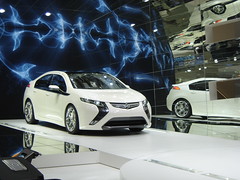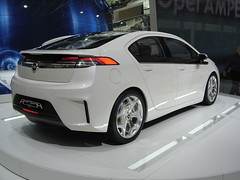
After Royal endorsement Ampera is making its PR rounds in UK. Very interesting is the spin in the FT article - this EV is "almost" like a "normal car".

"US Senate panel backs more electric cars, solar
Wed Jul 21, 2010
* Bill wants half of U.S. vehicles electrified by 2030
This is what we need to address dire consequences of Peak Oil. There is still time and technology available to us to electrify our transportation system. Electric cars are coming on the roads and Asian conglomerates are busy building Supply Chain for Electric Cars starting with lithium deposits. Will US Corp. finally awaken to this geopolitical problem?"
FT:
FT:
The Vauxhall Ampera
By John Griffiths
Published: July 24 2010 00:28
I have driven the future around the back lanes of Buckinghamshire, and it works – mostly. The Vauxhall Ampera, known to the wider world as General Motors’ Chevrolet Volt, has been proclaimed by GM as the holy grail of low fuel consumption and CO2 emissions.
Its technology overcomes both the daunting drawbacks of purely battery-powered electric cars and the relatively limited contributions conventional “hybrid” cars such as Honda’s Insight and Toyota’s Prius make to reduced fossil fuel consumption and CO2 emissions. This is despite their “green” image and the benefits they receive such as exemption from London’s £8 per day congestion charge. In the real world, both cars do well to achieve a (still laudable) 50-60 miles on a gallon of petrol and can go only very short distances on CO2-free battery power alone, mostly at crawling speed in stop-start urban traffic. On the open road, even though their modestly sized electric motor and battery pack drive in parallel with a petrol engine, the latter has to work almost as hard as a conventional car’s to maintain a satisfactory rate of progress.
So far, then, it is not much different from other battery-powered cars which, like the Ampera, can be plugged in at the office during the day in order to increase commuting distances.
The crucial difference becomes apparent when long distances are involved. I found when testing the £92,000 Tesla battery-powered sports car that the claimed 200-mile range fell closer to 100 when its power was used to the full, with 16 hours required for a full recharge using a household socket. BMW’s prototype battery-powered Mini had only slightly greater range (at the cost of losing the rear seats to make way for the battery pack).
Both will thus go considerably further than the Ampera without recharging. The crucial difference, however, is that when the Ampera’s batteries are in danger of running out of puff, it simply activates its own on-board petrol generator simultaneously to power the electric drive unit and to recharge the batteries. GM engineers insist this provides 350 miles of range using full performance before refuelling for generator or battery pack is required. But the Ampera’s advantage grows further in that even a three-hour dalliance with a conventional household socket is enough to kick the batteries back to full life and another 350 miles can be put under the wheels.
Unlike conventional hybrids, the Ampera’s wheels are driven exclusively by electricity. Its startlingly brisk performance is down to the 150 horsepower-equivalent electric drive motor, delivering its full, thumping 370 newton metres of torque from standstill. According to a GM spokesman, the per-mile cost of the Ampera using standard-rate electricity should be only about one-fifth that of a similar-sized conventional car.
Little of the above matters, however, if the Ampera turns out to be rotten to drive or, like the Tesla, costs several arms and legs more than its rivals. But GM has little to worry about on the drive experience.
The Ampera looks appealingly dramatic and executive sector-ish from the front, but is based on the same engineering platform as the Vauxhall Astra family car range built at Merseyside’s Ellesmere Port. It even drives like the comfortable but agile Astra, except on three counts. One is that the division of electric motor and battery pack between front and rear gives it almost 50-50 weight distribution, and thus even greater agility. The second is the liveliness of the acceleration thanks to maximum torque being available at any time. The third is the weird absence of mechanical noise when using battery power alone, and the tiny margin by which noise is increased when the petrol generator kicks in.
But the overwhelming sense in which the Ampera works is its lack of demands upon driver and passengers. Its interior space and seating are no different from conventional, similar-sized cars. The dashboard looks mildly futuristic and has some instruments, such as battery status and energy drawdown, which take a few seconds to learn. But otherwise it’s simply hop in, turn the key, engage the automatic gearshift and go. Refuelling the generator is straightforward via the garage petrol pump and the electric plug-in is likely to be problematical only to those who have to park in the street.
Where it only “mostly” works lies in pricing. Vauxhall, which is pitching hard to be allowed by GM to build Europe’s Amperas at Ellesmere Port, is projecting a UK launch price of about £30,000 if hopes of government “green” cash incentives of up to £5,000 per car go unrealised, as seems likely. That puts it well into BMW 3 Series territory and some £7,000 more than the most expensive Astra.
But factor in exemption from London’s congestion charge, zero road tax and the 300-plus gallons of fuel a year Vauxhall reckons can be saved compared with a 40mpg car by a driver covering 15,000 miles a year, and the gap looks considerably less formidable. The smug smirk of a green CO2 “hero” comes for free."
By John Griffiths
Published: July 24 2010 00:28
I have driven the future around the back lanes of Buckinghamshire, and it works – mostly. The Vauxhall Ampera, known to the wider world as General Motors’ Chevrolet Volt, has been proclaimed by GM as the holy grail of low fuel consumption and CO2 emissions.
 Image by harry_nl via Flickr
Image by harry_nl via Flickr
 Image by harry_nl via Flickr
Image by harry_nl via Flickr
Its technology overcomes both the daunting drawbacks of purely battery-powered electric cars and the relatively limited contributions conventional “hybrid” cars such as Honda’s Insight and Toyota’s Prius make to reduced fossil fuel consumption and CO2 emissions. This is despite their “green” image and the benefits they receive such as exemption from London’s £8 per day congestion charge. In the real world, both cars do well to achieve a (still laudable) 50-60 miles on a gallon of petrol and can go only very short distances on CO2-free battery power alone, mostly at crawling speed in stop-start urban traffic. On the open road, even though their modestly sized electric motor and battery pack drive in parallel with a petrol engine, the latter has to work almost as hard as a conventional car’s to maintain a satisfactory rate of progress.
 Image via Wikipedia
Image via Wikipedia
So far, then, it is not much different from other battery-powered cars which, like the Ampera, can be plugged in at the office during the day in order to increase commuting distances.
The crucial difference becomes apparent when long distances are involved. I found when testing the £92,000 Tesla battery-powered sports car that the claimed 200-mile range fell closer to 100 when its power was used to the full, with 16 hours required for a full recharge using a household socket. BMW’s prototype battery-powered Mini had only slightly greater range (at the cost of losing the rear seats to make way for the battery pack).
Both will thus go considerably further than the Ampera without recharging. The crucial difference, however, is that when the Ampera’s batteries are in danger of running out of puff, it simply activates its own on-board petrol generator simultaneously to power the electric drive unit and to recharge the batteries. GM engineers insist this provides 350 miles of range using full performance before refuelling for generator or battery pack is required. But the Ampera’s advantage grows further in that even a three-hour dalliance with a conventional household socket is enough to kick the batteries back to full life and another 350 miles can be put under the wheels.
Unlike conventional hybrids, the Ampera’s wheels are driven exclusively by electricity. Its startlingly brisk performance is down to the 150 horsepower-equivalent electric drive motor, delivering its full, thumping 370 newton metres of torque from standstill. According to a GM spokesman, the per-mile cost of the Ampera using standard-rate electricity should be only about one-fifth that of a similar-sized conventional car.
Little of the above matters, however, if the Ampera turns out to be rotten to drive or, like the Tesla, costs several arms and legs more than its rivals. But GM has little to worry about on the drive experience.
The Ampera looks appealingly dramatic and executive sector-ish from the front, but is based on the same engineering platform as the Vauxhall Astra family car range built at Merseyside’s Ellesmere Port. It even drives like the comfortable but agile Astra, except on three counts. One is that the division of electric motor and battery pack between front and rear gives it almost 50-50 weight distribution, and thus even greater agility. The second is the liveliness of the acceleration thanks to maximum torque being available at any time. The third is the weird absence of mechanical noise when using battery power alone, and the tiny margin by which noise is increased when the petrol generator kicks in.
But the overwhelming sense in which the Ampera works is its lack of demands upon driver and passengers. Its interior space and seating are no different from conventional, similar-sized cars. The dashboard looks mildly futuristic and has some instruments, such as battery status and energy drawdown, which take a few seconds to learn. But otherwise it’s simply hop in, turn the key, engage the automatic gearshift and go. Refuelling the generator is straightforward via the garage petrol pump and the electric plug-in is likely to be problematical only to those who have to park in the street.
Where it only “mostly” works lies in pricing. Vauxhall, which is pitching hard to be allowed by GM to build Europe’s Amperas at Ellesmere Port, is projecting a UK launch price of about £30,000 if hopes of government “green” cash incentives of up to £5,000 per car go unrealised, as seems likely. That puts it well into BMW 3 Series territory and some £7,000 more than the most expensive Astra.
But factor in exemption from London’s congestion charge, zero road tax and the 300-plus gallons of fuel a year Vauxhall reckons can be saved compared with a 40mpg car by a driver covering 15,000 miles a year, and the gap looks considerably less formidable. The smug smirk of a green CO2 “hero” comes for free."

No comments:
Post a Comment